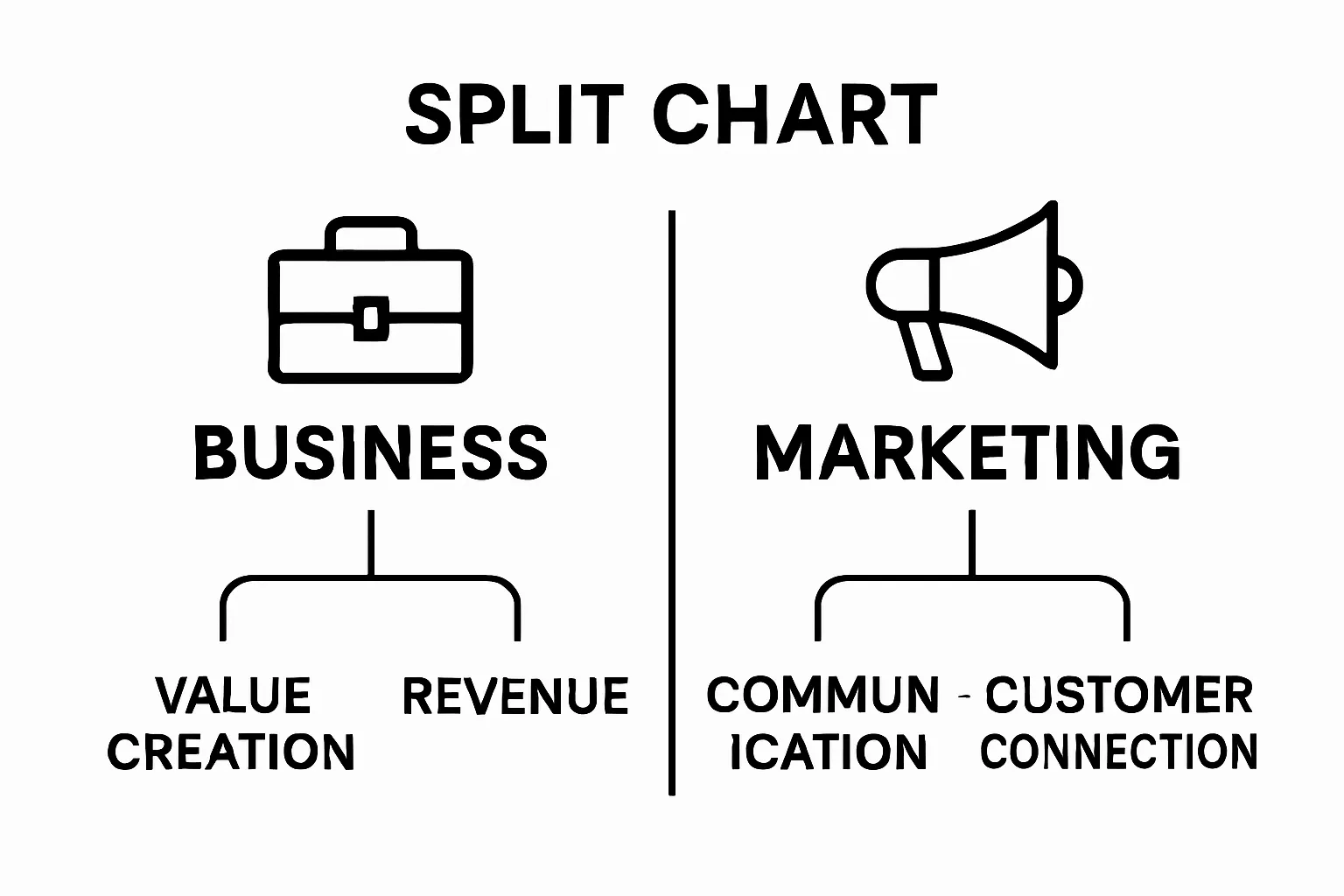How to Increase Brand Visibility with a Proven System

Explore the difference between business and marketing to gain clarity on their roles and importance in entrepreneurial success.

Every business you see—from massive global brands to your neighborhood bakery—exists to create value and solve real problems. Over 99 percent of all US businesses are actually small businesses and together, they employ more than 61 million people. Most people think a good product alone guarantees success. The real spark comes from understanding how business and marketing work together to turn ideas into impact and profit.
A business represents an organized effort to provide value by creating, delivering, and exchanging products or services for financial gain. Unlike simple transactions, businesses operate as structured entities with strategic objectives, operational frameworks, and sustainable models for generating revenue.
At its fundamental level, a business exists to solve problems and meet specific market needs. Whether manufacturing physical products, delivering digital services, or offering professional consulting, every successful business identifies a gap in the marketplace and develops solutions that address customer challenges. The core mission transcends merely making money—it centers on creating meaningful value that customers are willing to invest their resources to obtain.
The economic significance of businesses extends far beyond individual transactions. Businesses drive innovation, generate employment, stimulate economic growth, and contribute to societal development. They transform raw ideas into tangible products, convert intellectual capital into practical solutions, and create ecosystems where value is continuously generated and exchanged.
Successful businesses are built on several critical foundational elements that distinguish them from casual entrepreneurial attempts:
Beyond these technical aspects, businesses also represent human endeavors powered by vision, creativity, and strategic thinking. They are living organisms that adapt, evolve, and respond to changing market dynamics. The most resilient businesses maintain a delicate balance between maintaining core principles and embracing continuous transformation.
Understanding business is not just about comprehending economic mechanics—it’s about recognizing a powerful mechanism for creating positive change. Every successful business starts with a fundamental belief that it can contribute something meaningful to the world while simultaneously generating sustainable financial returns.
Marketing is a strategic communication process designed to connect businesses with potential customers by creating compelling narratives and meaningful interactions. More than simply advertising or selling, marketing represents a sophisticated approach to understanding audience needs, crafting resonant messages, and building long-term relationships between brands and consumers.
At its core, marketing transforms business potential into tangible customer connections. While businesses create products or services, marketing creates the context, meaning, and emotional relevance that compels people to engage. Marketing bridges the gap between what a business offers and what customers truly desire—translating functional capabilities into compelling human experiences.
Successful marketing goes beyond transactional thinking. It involves deep psychological understanding, strategic positioning, and nuanced communication that speaks directly to audience motivations. Marketers become translators who help businesses communicate their unique value in ways that resonate with specific audience segments, transforming abstract offerings into meaningful solutions.
Marketing strategies encompass multiple interconnected disciplines that work together to create comprehensive engagement approaches:
The most effective marketing strategies recognize that modern consumers seek authentic connections.
To help visualize the fundamental building blocks that drive success in each area, this table outlines essential components of business and marketing as described in the article.
| Area | Essential Component | Description |
|---|---|---|
| Business | Value Proposition | Unique offering that separates the business from competitors |
| Business | Revenue Model | Predictable system for generating consistent financial returns |
| Business | Operational Infrastructure | Systems enabling efficient service or product delivery |
| Business | Customer Understanding | Insights into target audience needs and preferences |
| Marketing | Audience Research | In-depth knowledge of customer demographics, psychology, and behaviors |
| Marketing | Brand Positioning | Unique market identity differentiating the business |
| Marketing | Communication Channels | Platforms and mediums selected to reach the target audience |
| Marketing | Narrative Development | Crafting stories linking offerings emotionally and rationally to customers |
| They demand transparency, value alignment, and genuine experiences that extend beyond traditional promotional tactics. Marketing has evolved from a one-way communication model to a dynamic, interactive dialogue where businesses listen as much as they speak. |
Ultimately, marketing represents an ongoing conversation between businesses and their audiences—a continuous process of understanding, adapting, and creating value. It transforms business potential into meaningful human experiences, connecting functional offerings with deeper emotional and practical needs.
While business and marketing are closely interconnected, they represent distinct yet complementary organizational functions with unique roles, objectives, and operational frameworks. Understanding their differences helps entrepreneurs create more effective strategies for growth and sustainable development.
Businesses fundamentally focus on creating and delivering value through products or services, establishing operational structures, and generating sustainable revenue. Their primary goal centers on building a viable economic entity that can consistently meet market demands. Marketing, however, operates as a specialized function within the broader business ecosystem, concentrating specifically on communicating value, understanding customer needs, and facilitating meaningful connections between the business and its target audience.
The business provides the foundational infrastructure—developing products, managing resources, establishing operational processes—while marketing translates these capabilities into compelling narratives that attract and engage potential customers. Think of business as the engine that produces value, and marketing as the communication system that ensures that value reaches and resonates with the right people.
To clarify the distinct focuses and contributions of business and marketing within an organization, the table below compares their foundational purposes, key activities, and performance metrics.
| Function | Primary Purpose | Key Activities | Common Performance Metrics |
|---|---|---|---|
| Business | Create and deliver value through products/services | Product development, operations, finance, resource management | Revenue, profitability, efficiency, sustainability |
| Marketing | Communicate value and build customer relationships | Audience research, messaging, branding, campaign management | Customer acquisition, brand awareness, engagement, conversions |
Businesses measure success through financial performance indicators like revenue, profitability, operational efficiency, and long-term sustainability. Their strategic focus encompasses comprehensive organizational development, including:
Marketing, by contrast, focuses on more nuanced performance metrics that reflect audience engagement and brand perception:
Ultimately, while businesses create the fundamental value proposition, marketing ensures that this value is effectively communicated, understood, and desired by potential customers. Their relationship is symbiotic—businesses provide the substance, while marketing provides the narrative that transforms potential into meaningful customer connections.

Business and marketing operate as interconnected systems that collectively transform potential into tangible results. Their interaction represents a dynamic partnership where strategic alignment determines organizational success, creating a synergistic relationship that goes far beyond traditional functional boundaries.
Successful businesses recognize that marketing is not a standalone department but an integral component of overall strategic development. Marketing provides critical insights that inform business strategy—understanding customer preferences, identifying market opportunities, and translating consumer behavior into actionable intelligence. Businesses leverage these insights to refine product development, optimize service offerings, and make informed strategic decisions.
The most effective organizations view marketing not as a cost center but as a strategic investment that directly contributes to business growth. By integrating marketing perspectives into core business planning, companies can develop more responsive, customer-centric approaches that anticipate and address evolving market dynamics.
The interaction between business and marketing functions involves several key collaborative mechanisms:
These collaborative mechanisms enable businesses to create more agile, responsive organizational models. Marketing provides the external perspective that helps businesses stay connected to changing customer needs, while business operations ensure that these insights can be effectively translated into tangible value propositions.
Ultimately, the most successful businesses view marketing not as a separate function but as a core strategic capability. They understand that sustainable growth requires continuous dialogue between internal capabilities and external market dynamics. By creating seamless interactions between business strategy and marketing insights, organizations can develop more nuanced, responsive approaches that transform potential into meaningful, measurable success.

Practical application of the distinctions between business and marketing functions reveals how strategic understanding can drive transformative growth. Real-world scenarios demonstrate that successful organizations leverage these complementary roles to create comprehensive, adaptive strategies that transcend traditional operational boundaries.
Early-stage entrepreneurs frequently encounter challenges in distinguishing between business fundamentals and marketing strategies. Consider a technology startup developing an innovative software solution. The business function focuses on product development, technological infrastructure, funding acquisition, and operational sustainability. Simultaneously, the marketing function works to understand target user needs, craft compelling positioning, develop communication strategies, and create pathways for customer acquisition.
In this context, the business provides the foundational product capabilities, while marketing translates technical features into meaningful value propositions that resonate with potential customers. Successful startups recognize that technical excellence alone cannot guarantee market success—strategic marketing transforms potential into tangible market traction.
Effective organizations demonstrate nuanced approaches to integrating business and marketing functions through strategic alignment:
Small businesses and entrepreneurial ventures particularly benefit from understanding these functional differences. By treating marketing not as an additional expense but as a strategic investment, organizations can develop more responsive, customer-centric approaches that anticipate and address evolving market needs.
Ultimately, the most successful organizations view business and marketing as interdependent systems. They create environments where operational capabilities and market insights continuously inform and enhance each other. This holistic approach transforms traditional functional boundaries into dynamic, collaborative frameworks that drive sustainable growth and meaningful competitive advantage.
Are you struggling to bridge the gap between your business fundamentals and effective marketing? The article you just read highlights how business growth depends on connecting clear value propositions and operational structure with marketing that actually resonates. Many founders get caught in the scattershot approach—pouring time and money into campaigns that are not aligned with their brand identity or long-term vision. If you want your business and marketing to work together, not against each other, you need more than just quick fixes. You need a system designed for real, sustainable growth.

That is why Reasonate Studio developed The Aligned Impact Model™. This proven framework aligns business foundations, strategic messaging, and audience insights so you stop feeling lost in DIY marketing tactics that drain your energy. Whether you are just getting started or looking to take your current brand to the next level, our process moves you from confusion to clarity and gives you the tools to scale with intention. Explore how the Aligned Impact Model™ works for small businesses and see how our blend of strategy, operational systems, and creative storytelling can help you grow. Don’t let misaligned marketing hold you back. Book a strategy session with us today and move your business forward with confidence.
Business focuses on creating and delivering value through products or services, while marketing is specifically aimed at communicating that value to potential customers and building relationships with them.
Business and marketing functions work collaboratively to ensure that market insights inform product development and that the value created by the business is effectively communicated to customers, enhancing overall growth.
Successful marketing strategies include audience research, brand positioning, effective communication channels, and narrative development to connect with customers emotionally and rationally.
Startups can distinguish these by focusing on business fundamentals like product development and sustainability, while simultaneously leveraging marketing strategies to understand customer needs and craft compelling value propositions.